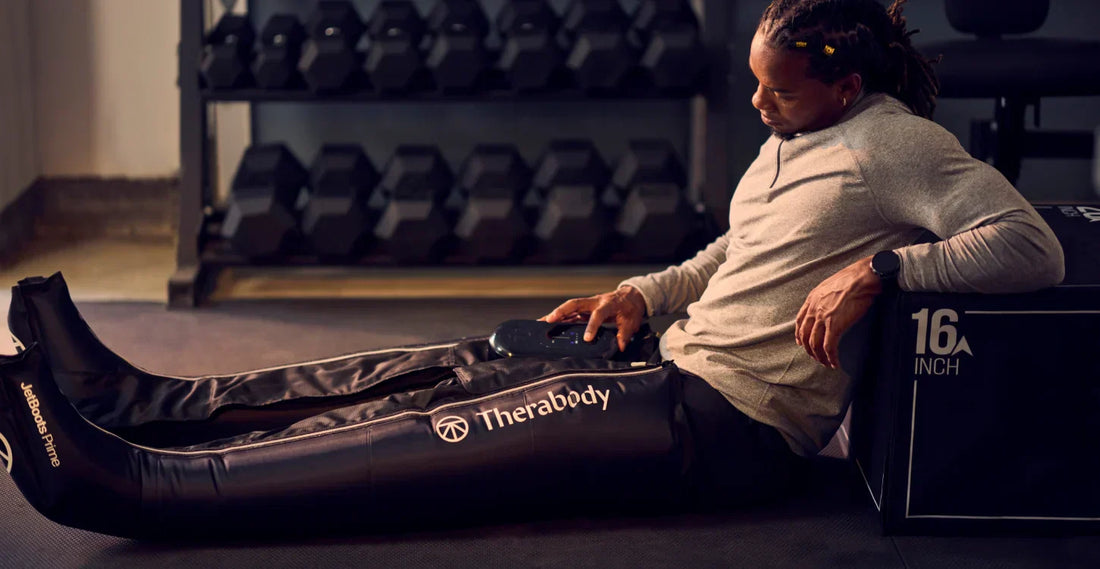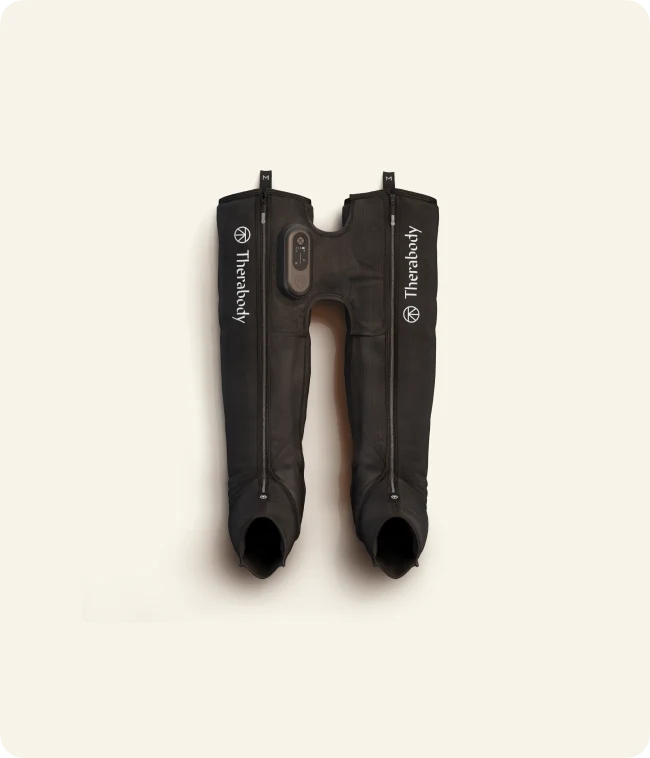
Daily Pneumatic Compression Therapy Mitigates Fatigue and Improves Recovery in Athletes in This New 5-Week Study
Authors: Therabody Scientists: Bailey McLagan, MS; Michelle Darian, MS, MPH, RD, LDN; Tim Roberts, MSc; Rachelle Reed, PhD, MS, ACSM-EP
Expert reviewer and study author: Dr. Iker Garcia Alday
High training loads can take a toll on the body, both mentally and physically. That’s why athletes of all levels rely on tools that can help them recover. Prioritizing recovery helps the body and mind get back to training faster and stronger.
It’s important that recovery strategies are not only anecdotally helpful — but also science-backed.
A recent study investigated whether pneumatic compression (the technology used in Therabody’s compressive leg sleeves) could improve the performance and recovery of handball players during a high training season.
Researchers found that daily use of Therabody’s JetBoots® during a 5-week training period helped mitigate fatigue that accompanies a high training load. These participants also reported feeling more recovered, and objective measures confirmed it. [1]
Let’s dive into the study, what researchers found, and what this can mean for your recovery routine during periods of high training.
How does pneumatic compression work?
Pneumatic compression is a therapy that uses air pressure delivered through a garment, typically boots or arm cuffs, to compress a limb.
This technology continuously inflates and deflates to move metabolic waste away from the tissues, while encouraging the delivery of blood and nutrients to the tissues. [2, 3, 4]
Intermittent sequential pneumatic compression (ISPC), the technology in Therabody’s compression boots, rhythmically inflates and deflates along the limb. This technology mimics the muscle pump to support the movement of fluids (including blood) towards the heart. [2, 4]
In periods of high training and competition demands, optimal recovery can impact everything from winning a competition to decreasing injury risk.
Most studies to date focus on the effect pneumatic compression has on recovery following a single bout of intense exercise.
This novel study, led by Dr. Iker Garcia Alday at the University of Barcelona, investigated the impact of daily pneumatic compression therapy on recovery and readiness over a 5-week period in highly active athletes.
“Most previous studies have analyzed the acute effects of intermittent pneumatic compression on performance and health parameters. Here, we investigated the impact of the sustained, daily implementation of this technology in the routine of team-sport players,” says Dr. Garcia.
Here, we’ll review this 2025 study.

What did the study investigate?
Researchers hypothesized that using pneumatic compression consistently over 5 weeks could help improve recovery, fatigue, and performance in competitive athletes.
Who were the participants?
Researchers recruited 17 nationally competitive male handball players to participate in the study. Handball is a fast-paced team sport where players score by throwing a ball into the opponent’s net.
Participants were randomly assigned to complete either an experimental protocol (8 players), which included daily pneumatic compression delivered by Therabody’s JetBoots Recovery Air 3 PRO model, or a control protocol (9 players).
Players were an average of 21 years old, had more than 10 years of experience training for handball, performed six hours of handball training per week, and competed in weekend matches. Goalkeepers were not included in the study.
How the study was conducted
Baseline measurements: Researchers collected baseline measurements of blood pressure on the arm and the ankle and muscle function metrics, activation of the muscle fiber, muscle fatigue, muscle damage, and a proxy for muscle stiffness. Sports performance tests, including the countermovement jump (CMJ) and the t-test (which measures agility through a series of forward, backward, and lateral movements) were also collected. [1, 5]
Intervention protocol: Participants in the intervention group completed a 30-minute pneumatic compression recovery session every day (after training sessions or at the end of a rest day) for 5 consecutive weeks. The compression pressure increased over the 5-week period, starting at 85 mmHg (week 1), then rising to 90 mmHg (weeks 2-3), and reaching 95 mmHg (weeks 4-5). Participants in the control group did not use any recovery intervention following training or competition. During the 5-week intervention, participants reported how difficult each session felt and how recovered they felt using questionnaires sent through an app.
Post-treatment measurements: After 5 weeks, all participants returned to the lab to complete follow-up testing of each baseline measurement.

Here’s what the study found
The study found that daily use of Therabody’s JetBoots helped mitigate fatigue, improved objective measures of recovery, and helped athletes feel more recovered, too.
When discussing the study findings, Dr. Garcia noted, “We demonstrated a reduction in the fatigue-induced effects of training, while enhancing hemodynamic regulation and psychological readiness, during a 5-week intervention.”
Let’s discuss what these findings mean.
Using the JetBoots pneumatic compression helped mitigate fatigue
Researchers found that participants who used the Therabody JetBoots were less fatigued than the control group.
After 5 weeks, agility worsened in the control group, indicating greater fatigue than in the intervention group, whose agility remained similar to baseline.
While the use of JetBoots didn’t lead to improvements in CMJ performance, attenuating the impact of high training loads on fatigue is still critical to individual and team performance.
This is particularly important for athletes with demanding training camps and season schedules that are susceptible to feeling more fatigued, which is reflected in their sports performance.
Blood pressure, an objective measure of exercise recovery, improved following JetBoots pneumatic compression use
Pneumatic compression significantly reduced local ankle blood pressure after the 5-week intervention, indicating stronger recovery. There were no significant differences in the control group.
“These findings may have significant implications for performance and health,” says Dr. Garcia.
During exercise, your heart works hard to pump blood to the rest of your body, increasing cardiac output (the amount of blood pumped by the heart per minute). This enhances the delivery of nutrients to your working tissues, raising your blood pressure. The time it takes blood pressure to return to baseline following exercise can indicate your degree of recovery, with longer recovery times pointing to higher recovery needs. [6, 7]
Previous studies have shown that using Therabody’s JetBoots immediately after exercise can improve cardiovascular recovery, resulting in a return of blood pressure to baseline and improving cardiac output and vascular resistance.

Participants felt more recovered following JetBoots pneumatic compression use
Participants who used pneumatic compression had higher perceived recovery status scores compared to the control group, meaning they reported feeling more physically recovered.
There was no significant difference between groups relating to session rating of perceived exertion (sRPE), indicating that the intervention group interpreted the difficulty of the sessions and competitions similarly to the control group.
Previous studies have shown that Therabody’s JetBoots improved post-exercise recovery metrics and improved perceived recovery immediately after cycling exercise. [8, 9]
However, it’s important to note that participants were not blinded to the intervention they were receiving, meaning a placebo effect in the intervention group may have been possible.
What this means for you
Daily pneumatic compression use can help mitigate the effects of training-related fatigue, improve the body's recovery response to training, and help you feel more recovered during an intense training or competition block.
Consider increasing the pressure of the compression boots each week until the maximum pressure is reached.
There are benefits to using pneumatic compression after exercise, but it’s important to remember that recovery and performance are impacted by various factors including nutrition, sleep, stress, hydration, and training regimen. [10]
This study was novel in that it investigated pneumatic compression use over a longer time. Additional studies of consistent, long-term use are needed to fully understand their ability to impact performance.
“This provides an ecological model of the performance, muscular, vascular, and psychological effects of using intermittent pneumatic compression with competitive athletes,” says Dr. Garcia.
Key takeaways
- A 2025 study investigated the impact of a 5-week pneumatic compression intervention on performance and recovery in 17 competitive athletes.
- Therabody’s JetBoots helped mitigate the effects of fatigue, improved metrics of recovery like ankle blood pressure, and helped participants feel more recovered the next day.
- By improving the circulation of blood and nutrients, daily pneumatic compression use is an effective recovery tool during training.
- More ecological, long-term studies are needed to understand pneumatic compression’s impact on performance and training-related fatigue.
References:
- Effects of daily use of intermittent pneumatic compression in competitive handball players: A randomized controlled trial
- Effects of Intermittent Pneumatic Compression on Delayed Onset Muscle Soreness (DOMS) in Long Distance Runners
- A systematic review of pneumatic compression for treatment of chronic venous insufficiency and venous ulcers
- Effects of lower-limb intermittent pneumatic compression on sports recovery: A systematic review and meta-analysis
- Tensiomyography: from muscle assessment to talent identification tool
- Exercise-Induced Hypertension in Healthy Individuals and Athletes: Is it an Alarming Sign?
- Relationship Between Blood Flow and Performance Recovery: A Randomized, Placebo-Controlled Study
- Effects of intermittent pneumatic compression on the recovery of cardiovascular parameters after repeated sprint exercise
- Intermittent sequential pneumatic compression reduces post-exercise hemodilution and enhances perceptual recovery without improving subsequent cycling performance
- Factors associated with high-level endurance performance: An expert consensus derived via the Delphi technique





